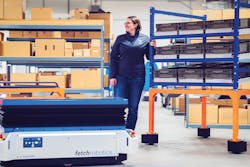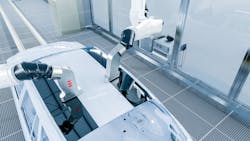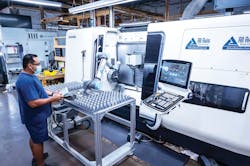Robotics Adoption Survey Finds Ups, Downs, and a Few Surprises
2020 proved to be a uniquely tumultuous and challenging year, beset not only by the unprecedented disruptions of the COVID-19 pandemic and its associated economic impacts, but the uncertainty that so often accompanies election years as businesses are forced to hold their breath on major decisions until the policy environment they will have to navigate over the next four years becomes more clear. Accordingly, a recent survey on robotics adoption conducted by Automation World shows some industry verticals seeing a huge uptick in robotics due to the need to socially distance, reshore supply chains, and increase throughput, while others saw investment stall as demand for their products cratered and their decision-making process became paralyzed by political and economic uncertainty.
Still, given the turbulent dynamics of the prior year, the general consensus among robotics suppliers—much of which is borne out in our survey data—is that strong growth remains expected in their space and robotic adoption should see continued acceleration in the near future.
Adoption to date
Of the respondents surveyed, 44.9% reported that their assembly and manufacturing facilities currently use robots as an integral part of their operation. More specifically, of those with robots, 34.9% have adopted collaborative robots (cobots), while the remaining 65.1% use only industrial robots.
With a few caveats, robotics suppliers interviewed for this article concur that the results of the survey were consistent with the overall landscape they see. However, they did note that adoption is clearly more advanced in some areas of industry than others.
For instance, automotive manufacturing in particular has seen a high penetration of robotics, having automated long before many other industry verticals. According to Mark Joppru, vice president for consumer segment and service robotics at ABB, this is not only because of the automotive industry’s ability to make high CAPEX investments, but also due to the rigid and standardized nature of automotive manufacturing, which can be accommodated by fixed robotics technologies.
Similarly, packaging has seen automation growth for the same reason, though many of the packaging machines that move products along lines would not qualify as robotics in the eyes of some. All the same, much use has been made in recent years of robotic arms, sometimes on mobile carts, at the beginning and end of packaging lines, where they perform material handling tasks, such as loading, unloading, and palletizing. It is in these end-of-line applications for which further growth of robotics in packaging is expected to take greater hold.
Meanwhile, smaller job shops and contract manufacturers—whose high-mix, low-volume (HMLV) production environments often require more flexibility—still have a long way to go when it comes to robotics adoption. Joe Campbell, senior manager of applications development at Universal Robots, feels that this is where much of the next wave of adoption is to be found. In fact, Campbell posits that overall adoption figures to date may be even lower than the 44.9% our survey detected, as he feels many of the small and medium enterprises (SMEs) his company serves are liable to fly under the radar, remaining essentially invisible to trade associations, industry surveys, and other data.
"There's a large chunk of the market that's really been underserved by the whole automation community, and we continue to uncover every week more and more [SMEs] that have very little automation, if any. They have no robots, and so that's a big growth area going forward," Campbell says. "A lot of surveys that associations and other publishers do might not be touching these people. They don't go to trade shows, and I don't know how many automation publications they're looking at, but these small companies have growth potential."
The COVID-19 effect
While many have opined that COVID-19 would accelerate robotics adoption, one of the biggest surprises of our survey was that 75.6% of respondents indicated that the pandemic did not drive any purchase of new robots within their facilities. Furthermore, of those who did bring in robots in response to the pandemic, 80% purchased five or less.
These findings do not, of course, mean that COVID-19 has had a wholly negative effect on robotics adoption, as several suppliers note. Rather, it may imply that the degree to which the pandemic has accelerated robotics is highly variable between different industries and applications. In some cases where manufacturers did purchase new robots throughout 2020 it may have been in response to other factors that were only indirectly tied to COVID-19, such as the need to increase throughput in verticals that saw a surge in demand or quickly meet labor requirements in fields where supply chain disruptions forced reshoring.
For example, Scott Marsic, senior project manager at Epson Robotics, points out that his company has seen strong adoption from medical equipment and device manufacturers facing soaring demand amid the need for personal protective equipment (PPE). Marsic stresses the primary interest in robots from these industries has been focused on increasing throughput rather than using robots to space out production for social distancing purposes. At the same time, the automotive industry—though already well-automated and a typical source of new robot purchases—has seen demand crater as lockdowns have reduced transportation demand exponentially. As a result, these companies have put large CAPEX spends on hold.
“I’ve put about 2,000 miles on my car in the past 10 months. I'm not getting oil changes or new tires,” Marsic says. “My demand is down and, if you look at automotive manufacturing, they've followed suit. If the demand is not there for automotive components, they won't invest in more automation. On the other side, if you look at fields where demand has gone up, like medical devices, pharmaceuticals, and even consumer packaging, they're seeing [increased] demand, and that's where the robots are being sold."
The logistics and warehousing spaces have also seen an uptick in robotics adoption for similar reasons, says Melonee Wise, CEO at Fetch Robotics. With more homebound consumers ordering all manner of goods online, demand has spiked.
On the topic of adopting robots for social distancing purposes, the overall response of those surveyed was fairly weak, with only 16.2% of respondents indicating it as a factor driving their decision to purchase new robots. More prominent reasons for robot purchase included cutting labor costs at 62.2%, increasing capacity at 54.1%, and navigating a lack of available workers at 37.8%.
On a related note, of those who did purchase robots in response to COVID-19, 45% indicated that they purchased cobots, while the remaining 55% opted for industrial robots. As cobots have often been held up as the best robotic solution for social distancing due to their ability to flexibly work alongside humans when attempting to space out a line or work cell, their lower-than-expected adoption rates among those responding to the pandemic may further highlight that concerns related to labor cost and availability, quality, and throughput are greater.
Forecasting future adoption
Looking ahead, the expectations of robotics suppliers are bullish, with many believing that with the elections over and increased availability of COVID-19 vaccines on the horizon, much demand will return in industries where market skittishness has slowed robotic adoption. Meanwhile, those industries already seeing an uptick are expected to plough ahead at an even faster pace.
As a potential caveat to suppliers’ high expectations, our survey results were a bit more modest, with slightly less than a quarter of respondents reporting that they plan to add robots in the next year. Of those respondents, 56.5% plan to purchase cobots and 43.5% plan to purchase typical industrial robots.
However, some suppliers suggest that the lower expectations apparent in the survey results might be misleading. For instance, Wise feels that, with installations of traditional fixed robotics systems sometimes taking as long as 9-15 months, many respondents who indicated they do not plan to add more robots in the next year may already have projects underway. In addition, Joppru notes that though only 23% of respondents plan to add robots, some may add a substantial amount, meaning that overall growth for the industry could be significantly higher.
In terms of the factors driving specific robot purchases, 52.8% said ease of use and 52.6% said end-of-arm-tooling options, while only 38.5% were interested in specific collaborative capabilities. This result seems to imply that flexibility, rather than collaborative safety features themselves, may be driving end-users’ growing preference for cobots.
This is most certainly reflected in the HMLV space where manufacturers are dealing with a challenging combination of high labor costs and labor shortages on the one hand, and shorter product lifecycles mandating rapid changeover and an increased degree of production variability on the other. Doug Burnside, vice president of North American sales and marketing at Yaskawa-Motoman, notes the paradox of dealing with rapid changeover using a manual workforce is actually easier, as human beings are, by their nature, adaptable. It’s only when automation is brought in that the process becomes more challenging. However, increasing flexibility enabled by the integration of vision, artificial intelligence, and more diverse and modular tooling options are helping to surmount these challenges.
Elsewhere too, there are some areas where robots may prove themselves useful that haven’t yet begun adoption. According to Joppru, ABB has had preliminary discussions with the oil and gas industry about integrating new types of robots into their field operations, though the realization of these projects may be years off.
“In oil and gas, there’s still a lot of manual processes that happen where three guys grab a pipe, and then they put a chain around it, grab a new pipe, and attach it so that they can drill another 20 feet,” Joppru says. “Could we automate that with some robotic arms that would eliminate a dull, dirty, and dangerous job? That’s one example, and we’ve had discussions with customers about this being a new area of penetration for robots that we just haven’t been able to go after yet.”
With that in mind, even should job shops, contract manufacturers, and SMEs become as robot-laden as the biggest automotive manufacturers, there will still be plenty of room for expansion in the future.
Companies in this Article

Leaders relevant to this article:


